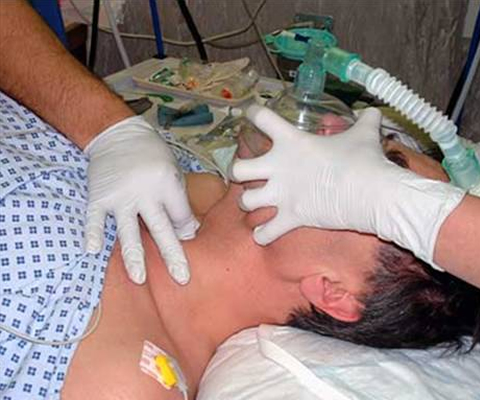Question 1: How should cricoid pressure be performed?
Click here for the answer.

Question 1: How should cricoid pressure be performed?
Answer: Light cricoid pressure (10 Newtons [N]) is applied before intravenous induction. The force is increased (30 N) after loss of consciousness. It is the responsibility of the anaesthetist to ensure that cricoid pressure has been applied. The direction of the force is posterior. A force of 30 N is approximately equal to a 3 kg weight.
Two-finger technique – the index finger and thumb are placed on each side of the cricoid arch, with force applied by both.
Three-finger technique – the thumb and middle finger are placed on each side of the cricoid arch with force applied by the index finger in the midline.
Question 2: Normally a single handed technique is used so that the assistant has a free hand. When might a two-handed technique be indicated?
Click here for the answer.

Question 1: How should cricoid pressure be performed?
Answer: Light cricoid pressure (10 Newtons [N]) is applied before intravenous induction. The force is increased (30 N) after loss of consciousness. It is the responsibility of the anaesthetist to ensure that cricoid pressure has been applied. The direction of the force is posterior. A force of 30 N is approximately equal to a 3 kg weight.
Two-finger technique – the index finger and thumb are placed on each side of the cricoid arch, with force applied by both.
Three-finger technique – the thumb and middle finger are placed on each side of the cricoid arch with force applied by the index finger in the midline.
Question 2: Normally a single handed technique is used so that the assistant has a free hand. When might a two-handed technique be indicated?
Answer: A two-handed technique is used if a cervical spine fracture is suspected. The second hand is placed behind the neck to prevent posterior displacement of the spine on applying cricoid pressure. Manual in-line stabilization of the neck must also be used.
